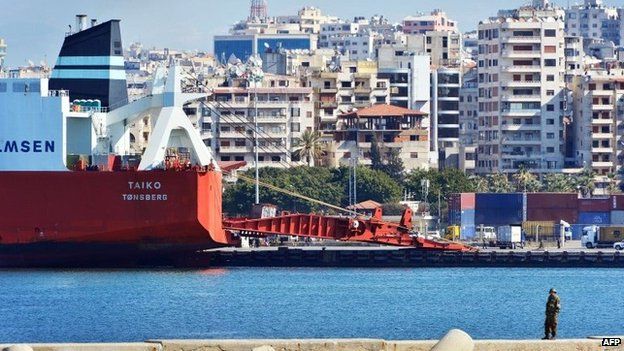Syria submits new plan to ship chemicals arms by April
- Published

Syria has submitted a new plan for the removal of its chemical weapons, months after the expiry of the deadline set by the international community.
The Organisation for the Prohibition of Chemical Weapons (OPCW) said Damascus hoped to ship its most dangerous chemicals abroad by the end of April.
About a third of them will have been removed by the end of this week.
Despite the delays, the head of the joint OPCW-UN mission insisted that there had been "good progress".
Dutch diplomat Sigrid Kaag said the end of June deadline for the total destruction or removal of Syria's chemical arsenal was still achievable.
Elsewhere, government forces backed by fighters from the Lebanese Shia Islamist movement Hezbollah reportedly stepped up their bombardment of Yabroud, the last rebel stronghold in the Qalamoun mountains.
'New momentum'
Six more consignments of chemicals will leave Syria's Mediterranean port of Latakia by the end of the week, the OPCW said, as part of a US- and Russian-brokered deal agreed last year after a deadly chemical attack outside Damascus.
A quantity of the blister agent sulphur mustard was shipped on Wednesday, it said. A significant consignment of other "Priority 1" chemicals was scheduled to arrive in Latakia this week, it added.
The six consignments represent more than 35% of all chemicals that must be removed from Syria for destruction, including 23% of Priority 1 chemicals and 63% of less hazardous Priority 2 chemicals.
The removal of Priority 1 chemicals was due by 31 December, while the deadline for the shipment of Priority 2 material was 5 February.
The OPCW has also verified that Syria destroyed more than 93% of its stock of isopropanol, a dual-use chemical that is one of two key ingredients for sarin, a nerve agent used in the attack on several suburbs of Damascus on 21 August that left hundreds dead.
The international watchdog's director general said all materials and equipment required by Syria were now in place for the "expeditious removal" of its remaining chemicals, including armoured jackets for the protection of containers.
"Given delays since the lapse of the two target dates for removal, it will be important to maintain this newly created momentum," Ahmet Uzumcu said.
Ms Kaag, the special co-ordinator for the OPCW-UN joint mission, said: "This is good progress and I expect further acceleration and intensification of effort."
In a separate interview with the Associated Press, Ms Kaag said she had agreed with the Syrian government a 60-day timetable for shipments and anticipated "a lot of action" in March.
'Barrel bombs'
Fighting in and around Yabroud, about 60km (37 miles) north of Damascus, left dozens of people dead on Monday, including some 17 rebels and 19 soldiers, pro-government militiamen and Hezbollah fighters, according to the UK-based Syrian Observatory for Human Rights.
Thousands have fled the Yabroud area and crossed into northern Lebanon since the government air strikes began last month.
An army officer told journalists during a tour of government-held areas around Yabroud that civilians were still leaving, meaning the fighting was still light. He declined to say when a ground assault might begin.
The government launched an offensive in mid-November to oust rebel fighters from the Qalamoun mountains, cut off their cross-border supply routes and establish firm control over the motorway linking Damascus with the city of Homs.
In the capital, activists reported fresh fighting on the edge of the Yarmouk Palestinian refugee camp, with military helicopters dropping barrel bombs.
Thousands of civilians are trapped in Yarmouk, which has been under siege for eight months and has seen severe food shortages.
A fragile truce between rebels and Palestinian militants loyal to President Bashar al-Assad inside the camp broke down on Sunday, leading aid workers to stop distributing food parcels there.
Syrian chemical weapons: How the plan will unfold
- 1. The Syrian authorities are responsible for packing and safely transporting the chemical weapons from 12 sites across the country to the port of Latakia. Russia has supplied large-capacity and armoured lorries, while the US has sent container drums and GPS locators.
- 2. Russia is providing security for loading operations at Latakia, for which the US has supplied loading, transportation and decontamination equipment. China has sent 10 ambulances and surveillance cameras, and Finland an emergency response team in case of accidents.
- 3. Denmark and Norway are providing cargo ships and military escorts to take the chemicals to the container port of Gioia Tauro in Italy. Russia and China are also providing naval escorts and the first consignment of 16 tonnes left Latakia on 7 January.
- 4. In Italy, the "most critical" chemical agents will be loaded onto the US Maritime Administration cargo ship, MV Cape Ray, to be destroyed by hydrolysis in international waters. Less-toxic chemicals will be shipped by Norwegian and Danish vessels for disposal at commercial facilities.